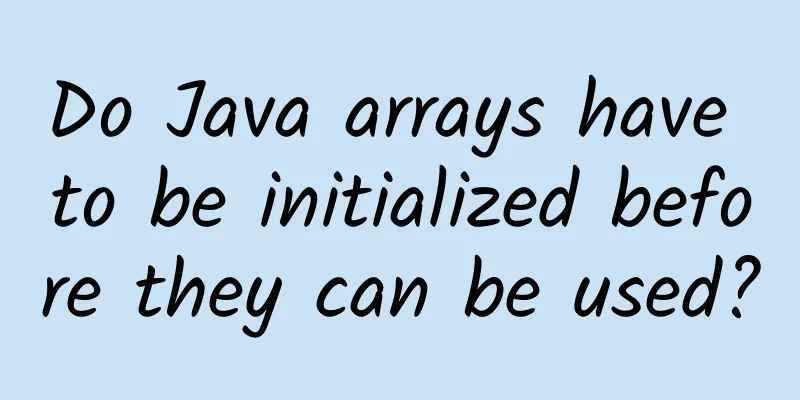Do Java arrays have to be initialized before they can be used?

|
An array is a composite structure provided by most programming languages. If a program requires multiple variables of the same type, you can consider defining an array. The array variable of the Java language is a reference type variable, so it has unique characteristics of Java. In normal Java development, before using Java arrays, we will initialize the arrays, allocate memory space for the elements in the array, assign values, etc., but is it necessary to initialize Java arrays? Is it okay not to initialize? In fact, Java array variables are reference type variables, not array objects themselves. As long as the array variable points to a valid array object, the array variable can be used in the program, such as the following example:
From the above code, we can see that after defining the prices array, the prices array is not initialized. When int prices[] is executed, The memory allocation of the program is shown in the figure As can be seen from the figure, at this time the prices array does not point to any valid memory, does not point to any array object, and the program cannot use the prices array variable at this time. After the program executes prices = nums, the prices variable will point to the array referenced by the nums variable. At this time, the prices variable and the nums variable reference the same array object. After executing this statement, the prices variable already points to valid memory and an array object of length 4, so the program can use the prices variable normally. For array variables, it does not need so-called initialization. As long as the array variable points to a valid array object, the program can use the array variable normally. Therefore, arrays in Java language can be used normally without initialization. Java beginners can try to use the method in the above example to deepen their impression. ***, I hope my sharing is helpful to everyone. |
>>: A preliminary study on the method of “design that touches people’s hearts”
Recommend
Effective techniques to increase followers through Baidu promotion! Replicable practical cases!
In the cold winter of the Internet, many friends ...
China Passenger Car Association: China imported 56,000 vehicles in January-February 2025, a year-on-year decrease of 46%.
Cui Dongshu, secretary general of the China Passe...
Did you know? Protecting dental health should start from primary and secondary school students!
Author: Tang Qin, Deputy Secretary-General and Re...
100 days, 1000 meters, a new starting point
Today marks the 13th month that Tianwen-1 has bee...
Wrong "light diet" may lead to dementia! What doctors mean by "light diet" is actually...
I believe everyone is familiar with this scene in...
Have you ever seen a golden mosquito?
Some time ago, Dalian Customs in Liaoning capture...
The latest ranking of 50 information flow advertising media platforms!
Friends who are involved in advertising know that...
How much is the CBA championship prize money? How much prize money does the Guangdong team, the ten-time CBA champion, get?
As the fourth quarter of the third game of the fi...
Comparing the two years of Stanford AI reports: 32 charts to help you fully understand the development of the industry
The AI Index project of Stanford University'...
Where's my nose? Why can't I see it?
Audit expert: Liu Dongbao Chief Physician of Opht...
To protect the security of WeChat and Alipay, use these five functions of your mobile phone with caution!
Nowadays, Alipay and WeChat are the most common t...
Mimi Meng, Youshu, Tongdao Dashu, Xin Shixiang... How do they attract fans?
We often say that the biggest difference between ...
The research has confirmed: If you are sleepy but don’t sleep, your DNA will be damaged!
We all know that humans spend 1/3 of their lives ...
Who should get the "fourth shot" of the vaccine? What vaccine should be given as the "fourth shot"? Expert answers
Who should get the "fourth shot" of the...
A complete manual for new media operations: detailed explanations of how to use Bilibili, Zhihu, Xiaohongshu, etc.
Lei Jun, chairman of Xiaomi, opened a Xiaohongshu...



![[Emergency Science Popularization] @Everyone, please check out this guide for safe travel in heavy rain!](/upload/images/67f2a66fcc403.webp)





